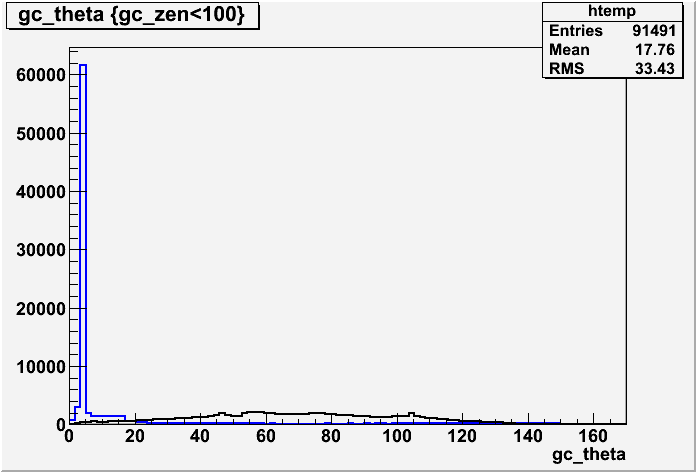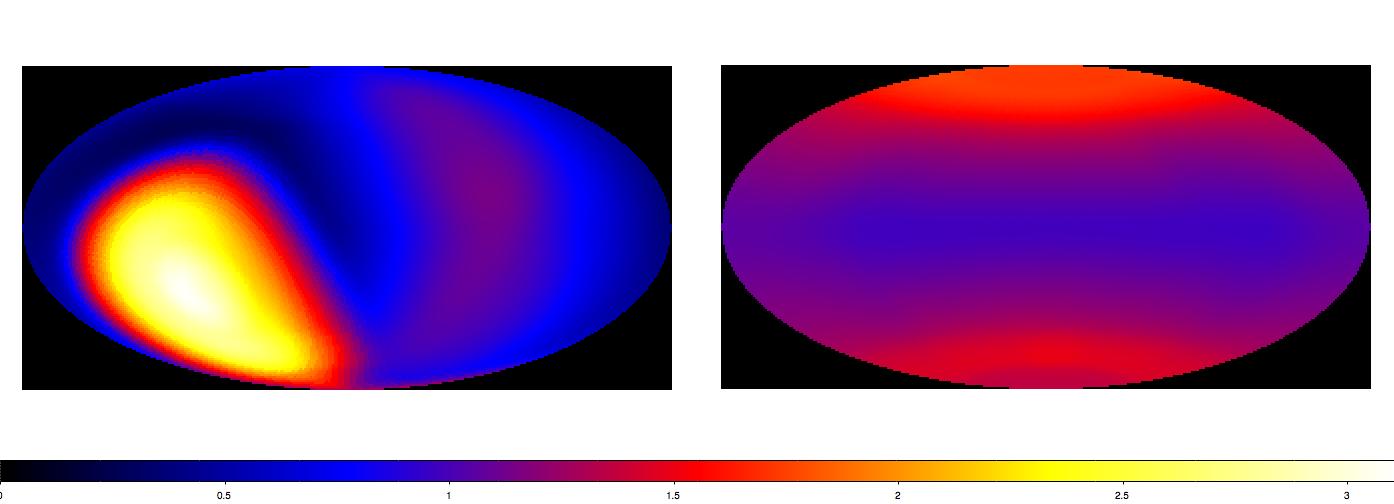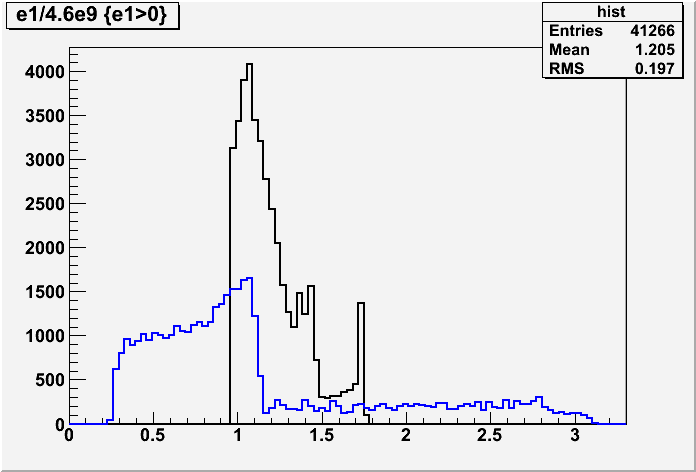Evaluation of Option 1 Observing Strategy
Brief Description of the Observation Strategy
Point at RA, Dec 261.4, -28.9 (5 deg offset in RA from Galactic Center). Transition into 50 degree rocking survey when target is 10 degrees from Earth occultation, the commence slew back to target when target is exiting 10 deg from Earth occultation. EAA is set to 30 deg, so LAT boresight will track to within 30 deg of Earth limb and then hold steady until target reaches 10 deg to Earth limb. The spacecraft (FT2) files for the option 1 observing strategy and for a comparison 50 deg rocking profile survey mode can be found on the parent to this page.
Each spacecraft (FT2) file is for 56 days (just a bit longer than a precession period).
Fraction of Time that the Galactic Center is within 45 deg of LAT Boresight

This figure shows the distribution of Galactic Center theta. Each entry in the histogram corresponds to a 30 second interval. Blue is option 1, black is 50 deg survey mode.
The galactic center is within 45 deg of the LAT boresight for 7.00 days in survey mode and for 28.0 days in option 1. This is a factor of 4.0 improvement. Note that this includes time in the SAA (we are not observing during SAA intervals). A zenith cut of 100 was applied.
All sky Exposure (integrated over 56 days)
Here are all sky exposure maps for option 1 and for the comparison survey mode. They have been divided by an exposure of 4.6e9 cm^2 s, which is roughly the exposure at the Galactic center for the 50 deg rocking survey mode case.
The exposure was calculated using gtltcube (zmax=100) and gtexpcube for P7V6Source response at 10 GeV. A 100 deg zenith cut has been applied. SAA intervals were excluded from the calculation.

The survey mode map (right hand panel) is not quite uniform in RA due to SAA outages and because 56 days is a little longer than a precession period. The over exposure at the north and south poles are due to the 50 deg rocking profile in which the orbit pole spends most of its time at 40 deg from the LAT boresight and so collects lots of exposure.
The option 1 map (left hand panel) has a large region around the Galactic center with a factor 2-3.0 boost in exposure relative to the GC exposure for survey mode. The exposure uniformity is a little worse for this observation compared with survey mode, but all regions of the sky still have some exposure.
To make it easier to see this more quantitatively, a histogram of the pixels was constructed for the above two exposure maps. The blue curve is for option 1 and the black for survey mode. The units are the same as before (exposure at the GC in survey mode).

The uniformity is a little better for survey mode than for option 1, but this is not relevant if there are no science drivers for all-sky uniformity on timescales of 56 days. The more relevant metric is uniformity on short timescales (hours/days) as this supports source monitoring.
Observation Efficiency
Observations that bring the LAT FoV across the Earth lose some exposure due to blockage from the Earth/zenith cuts. Thus changing the observation strategy doesn't just redistribute exposure, it can also result in loss of exposure due to zenith cuts. One way to quantify the observation efficiency is to compare the mean exposure (reported by gtexpcube) for option 1 and for survey mode. These are 5.13e9 cm^2 s for option1 and 5.54e9 cm^2 s for survey. Thus the percentage loss in efficiency between option1 and survey mode is 7.4%.
Summary
The following metrics are calculated at 56 day interval, 10 GeV, P7V6SOURCE, zenith cut of 100 deg and exclude the SAA (unless otherwise noted).
| Option1 | Survey | option1/survey | |
|---|---|---|---|
| Fraction of time GC within 45 deg (includes SAA) | 28.0 days | 7.0 | 4.0 |
| Exposure (in units of GC exposure in survey mode) | 3.0 | 1 | 2.8 |
| mean exposure over entire sky | 5.13e9 | 5.54e9 | 0.926 |
Additional Considerations:
- Coverage of entire sky on most days and most 2 orbit intervals with option1.
- Increase EAA to 30 deg - will cause additional latency for some ARR (those close to the pole)
- Shorter continguous observations with option 1 relative to survey mode, as we are no longer keeping the continuous viewing zone near the orbit poles within the FoV for each orbit.
It's also clear from the daily exposure movie that there are times in the precession period where the daily exposure is more uniform. These presumably correspond to periods where the pointed observation is at or close to the orbit plane. This suggests that pointing at the orbit plane might give the best exposure uniformity on short timescale (important for sky monitoring). Increasing the EAA would improve the exposure efficiency, but at a price of poorer ARR response.



